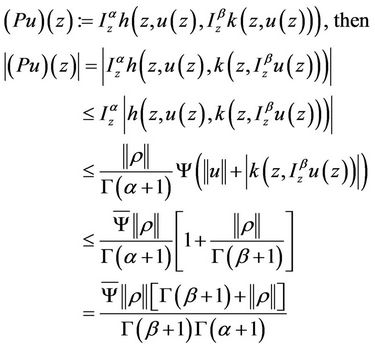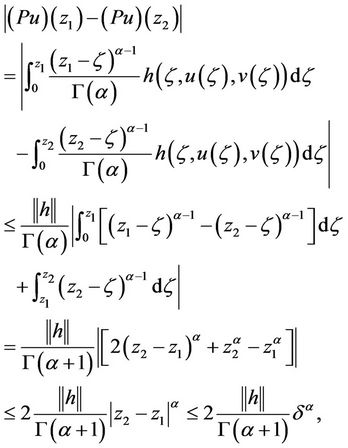Integral Means of Univalent Solution for Fractional Differential Equation ()
1. Introduction
Recently, the theory of fractional calculus has found interesting applications in the theory of analytic functions. The classical definitions of fractional operators and their generalizations have fruitfully been applied in obtaining, for example, the characterization properties, coefficient estimates [1], distortion inequalities [2] and convolution structures for various subclasses of analytic functions and the works in the research monographs. In [3], Srivastava and Owa, gave definitions for fractional operators (derivative and integral) in the complex z-plane  as follows:
as follows:
Definition 1.1. The fractional derivative of order  is defined, for a function
is defined, for a function  by
by

where the function  is analytic in simply-connected region of the complex z-plane
is analytic in simply-connected region of the complex z-plane  containing the origin and the multiplicity of
containing the origin and the multiplicity of  is removed by requiring
is removed by requiring  to be real when
to be real when 
Definition 1.2. The fractional integral of order  is defined, for a function
is defined, for a function , by
, by

where the function  is analytic in simply-connected region of the complex z-plane (
is analytic in simply-connected region of the complex z-plane ( ) containing the origin and the multiplicity of
) containing the origin and the multiplicity of  is removed by requiring
is removed by requiring  to be real when
to be real when 
Remark 1.1.

and

Further properties of these operators can be found in [4,5].
2. Preliminaries
Let  be the class of all normalized analytic functions
be the class of all normalized analytic functions  in the open unit disk
in the open unit disk  satisfying
satisfying  and
and  Let
Let  be the class of analytic functions in U and for any
be the class of analytic functions in U and for any  and
and 
 be the subclass of
be the subclass of  consisting of functions of the form
consisting of functions of the form 
For given two functions F and G, which are analytic in U, the function F is said to be subordinate to G in U if there exists a function h analytic in U with

such that

We denote this subordination by . If G is univalent in U, then the subordination
. If G is univalent in U, then the subordination  is equivalent to
is equivalent to  and
and 
Lemma 2.1 [6]. If the functions f and g are analytic in U then

Lemma 2.2 [7]. Let f, g be analytic function in U. Assume that 
 and
and  is univalent in U. If
is univalent in U. If

then 
Our work is organized as follows: In Section 2, we will derive the integral means for normalized analytic functions involving fractional integral in the open unit disk U

In Section 3, we study the existence of locally univalent solution for the fractional diffeo-integral equation
 (1)
(1)
subject to the initial condition  where
where  is an analytic function for all
is an analytic function for all  and
and 
 are analytic univalent functions in
are analytic univalent functions in . The existence is shown by using Schauder fixed point theorem while the uniqueness is verified by using Banach fixed point theorem.
. The existence is shown by using Schauder fixed point theorem while the uniqueness is verified by using Banach fixed point theorem.
For that purpose we need the following definitions and results:
Let M be a subset of Banach space X and  an operator. The operator A is called compact on the set M if it carries every bounded subset of M into a compact set. If A is continuous on M (that is, it maps bounded sets into bounded sets) then it is said to be completely continuous on M. A mapping
an operator. The operator A is called compact on the set M if it carries every bounded subset of M into a compact set. If A is continuous on M (that is, it maps bounded sets into bounded sets) then it is said to be completely continuous on M. A mapping  is said to be a contraction if there exists a real number
is said to be a contraction if there exists a real number  such that
such that 
Theorem 2.1. Arzela-Ascoli let E be a compact metric space and  be the Banach space of real or complex valued continuous functions normed by
be the Banach space of real or complex valued continuous functions normed by

If  is a sequence in
is a sequence in  such that
such that  is uniformly bounded and equi-continuous, then
is uniformly bounded and equi-continuous, then  is compact.
is compact.
Theorem 2.2. (Schauder) Let X be a Banach space,  a nonempty closed bounded convex subset and
a nonempty closed bounded convex subset and  is compact. Then P has a fixed point.
is compact. Then P has a fixed point.
Theorem 2.3. (Banach) If X is a Banach space and  is a contraction mapping then P has a unique fixed point.
is a contraction mapping then P has a unique fixed point.
3. Existence and Uniqueness
In this section, we established the existence and uniqueness solution for the diffeo-integral Equation (1). Let  be a Banach space of all continuous functions on U endowed with the sup. norm
be a Banach space of all continuous functions on U endowed with the sup. norm 
Lemma 3.1. If the function h is analytic, then the initial value problem (1) is equivalent to the nonlinear Volterra integral equation
 (2)
(2)
In other words, every solution of the Volterra Equation (2) is also a solution of the initial value problem (1) and vice versa.
The following assumptions are needed in the next theorem:
(H1) There exists a continuous function  on U and increasing positive function
on U and increasing positive function  such that
such that

with the property that

Note that  is the Banach space of all continuous positive functions.
is the Banach space of all continuous positive functions.
(H2) There exists a continuous function p in U, such that

Remark 3.1. By using fractional calculus we observe that Equation (2) is equivalent to the integral equation of the form
 (3)
(3)
that is, the existence of Equation (2) is the existence of the Equation (3).
Theorem 3.1. Let the assumptions (H1) and (H2) hold. Then Equation (1) has a univalent solution  on U.
on U.
Proof. We need only to show that  has a fixed point by using Theorem 1.2 where
has a fixed point by using Theorem 1.2 where
 (4)
(4)
where  Thus we obtain that
Thus we obtain that

that is  Then P mapped
Then P mapped  into itself. Now we proceed to prove that P is equicontinuous. For
into itself. Now we proceed to prove that P is equicontinuous. For  such that
such that 
 ,
, . Then for all
. Then for all  where
where

we obtained

which is independent of u.
Hence P is an equicontinuous mapping on S. Moreover, for ,
,  such that
such that  and under assumption (H1), we show that P is a univalent function. The Arzela-Ascoli theorem yields that every sequence of functions
and under assumption (H1), we show that P is a univalent function. The Arzela-Ascoli theorem yields that every sequence of functions  from
from  has a uniformly convergent subsequence, and therefore
has a uniformly convergent subsequence, and therefore  is relatively compact. Schauder’s fixed point theorem asserts that P has a fixed point. The univalency of the function h yields that u is a univalent solution.
is relatively compact. Schauder’s fixed point theorem asserts that P has a fixed point. The univalency of the function h yields that u is a univalent solution.
Now we discuss the uniqueness solution for the problem (1). For this purpose let us state the following assumptions:
(H3) Assume that there exists a positive number L such that for each ,
,  and
and 

(H4) Assume that there exists a positive number  such that for each
such that for each  we have
we have

Theorem 3.2. Let the hypotheses (H1-H4) be satisfied. If  then (1) admits a unique univalent solution
then (1) admits a unique univalent solution 
Proof. Assume the operator P defined in Equation (4), we only need to show that P is a contraction mapping that is P has a unique fixed point which is corresponding to the unique solution of the Equation (1). Let , then for all
, then for all  we obtain that
we obtain that

Thus by the assumption of the theorem we have that P is a contraction mapping. Then in view of Banach fixed point theorem, P has a unique fixed point which corresponds to the univalent solution (Theorem 3.1) of Equation (1). Hence the proof.
The next result shows the integral means of univalent solutions of problem (1).
Theorem 3.3. Let ,
,  be two analytic univalent solutions for the Equation (1) satisfying the assumptions of Lemma 2.2 with
be two analytic univalent solutions for the Equation (1) satisfying the assumptions of Lemma 2.2 with  and
and  then
then

Proof. Setting ,
,  , Lemma 2.2 implies that
, Lemma 2.2 implies that . Hence in view of Lemma 1.2, we obtain the result.
. Hence in view of Lemma 1.2, we obtain the result.
Example 3.1. Consider the fractional problem
 (5)
(5)
where  and
and  We observe that
We observe that  and
and  and
and

where  and
and  Thus in view of Theorem 3.1, the problem (5) has a solution in the unit disk.
Thus in view of Theorem 3.1, the problem (5) has a solution in the unit disk.